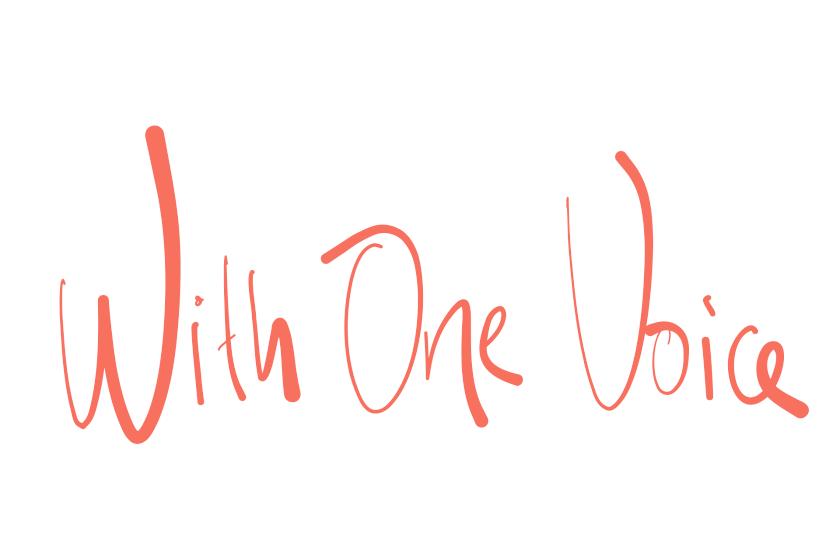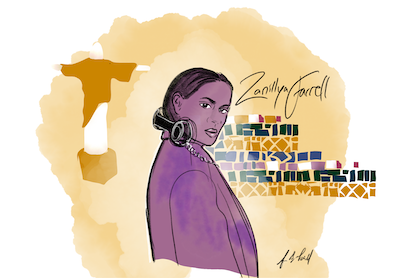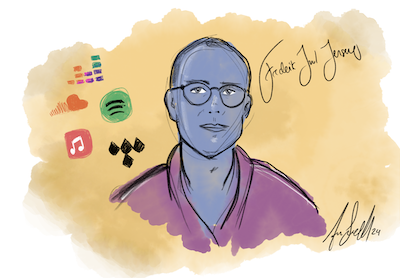
With One Voice - March 2024
Available in English, French, Spanish, and Portuguese
CIAM held its first international women's songwriting camp featuring Zanillya, who shares lessons learned in Rio de Janeiro. Discover new streaming revenue models discussed in a recent study by PhD researcher Frederik Jul Jensen. The Latin music market is impacting cultural, economic and political changes. Finally, get informed over collective management models and how they provide harmony for creators.
Sign up to receive the With One Voice newsletter here.

Lessons from a Rio writing camp
Gathering in the lobby, the air was charged with excitement and anticipation. We were a collective of creative women, about to embark on a musical journey at Visom Digital studio, just a stone's throw from our hotel in Rio. The studio owner shared his story and the history of Baile Funk and feminism, which was incredibly fascinating. We listened to tracks from renowned Brazilian artists mixed in Dolby Atmos, including the superstar Anitta.
Our challenge began with group collaborations. My first session was with producer Phoenix Pagliacci from Canada and artist/singer-songwriter Jade Baraldo from Brazil. The session had a slow start due to technical issues. Despite the initial frustration, we decided to create a track organically, starting with only a bassline. Improvising with just vocals and claps, we crafted a unique and interesting song. This experience taught me the importance of resourcefulness. It emphasized the need to master every aspect of my work to be able to step in when necessary. Nonetheless, we made the best of it, and in the end, we were all proud to have created a complete song.
On the final day, we had a seminar where I, as a panelist, addressed the hurdles we face as women in the music industry. The camp culminated in a listening session were we shared our new tunes. I was proud to present what we, as women, had created, and the audience was enthusiastic, concluding the writers' camp on a high note.
This camp wasn't just about music; it helped me better understand myself. I will use these insights to enhance my skills as an artist. The gender disparity in music producers in the Netherlands is stark, with only 13% of Buma/Stemra members being women. This fact deeply affected me. I am proud to be part of that 13% and to have participated in this women's writing camp.
During the camp, I learned that it is crucial for women to master our craft thoroughly and work hard. In this way, we can break free from gender-stereotyped views of 'female composers.' As women, we must showcase ourselves, seize opportunities, and not be afraid to promote our talents. I am confident that doing so will offer us more chances and lead us to the positions where we belong.
I want to thank you again for this opportunity. It has made me wiser, and I look forward to what the future holds. Let's work together towards a world where women are proportionally represented.
Thanks,
Zanillya Farrell

New streaming revenue models
For a decade, streaming payments have remained largely unchanged. However, we have recently witnessed a radical change where multiple models have appeared, and even more are being discussed. The most controversial might be the threshold of Spotify, where tracks need a minimum of 1.000 streams a year before being monetized. Apple Music introduced a redistribution from the Pro Rata pie to music in Spatial Audio. Deezer and Universal introduced a new ‘artist’ centric’ royalty model that gives artists with over 1,000 monthly listeners a double boost that is also applied if a listener actively searched for an artist.
PhD researcher Frederik Juul Jensen conducted a study evaluating six new potential payment systems. Central to the study is a critique of the existing Pro Rata payment model, saying that it fails to directly link an individual subscription fee to the listeners’ specific listening habits. The models discussed are:
- User Centric Payment System (UCPS) where money from one subscription goes only to the music that specific listener listens to.
- Factoring listening length in stream counts to eliminate discrimination between long and short-form content.
- Factoring listening context by differentiating active and passive listening. Previously, the two ways to differentiate were through radio discovery, which traditionally paid less, and actively purchasing music.
- Excluding the user’s first stream, making it possible to listen and discover new music, but only monetize the music the listener returns to. This could have a positive effect on artists with a traditional career, and redistribute from music featured on focus playlists and those like “New Music Friday”, except the music listeners like and listen again to.
- The artist growth model is a redistribution from top earners to mid-layer artists addressing the “winner-takes-all” effect where 3% of artists make 98% of the revenue (according to Deezer). This might have different understandings of success across countries, making application difficult. It might also indirectly benefit passive listening. However, it is “the most explicit alternative to limit superstardom” according to Frederik.
- Minimum threshold system tackling the challenge that streaming services become cloud services for music that nobody listens to. With 100,000 songs being added daily, and the growing impact of AI, this problem only becomes bigger (45 million tracks have 0 listens). Spotify integrated this with a threshold of 1,000 yearly streams, but Mark Mulligan suggests 10,000 yearly streams as a threshold.
With all the models discussed, Frederik Juul Jensen suggests that a blend of alternative models would consider the breadth of an artist’s listener base and depth of engagement with their music. It would offer a more viable solution to the current system’s challenges.
The New Revolution
Gone are the days when Latin music was nothing more than an anecdote for the US market.
Just 30 years ago, people predominantly listened to Regional Mexican music in California and some cities in Texas, while salsa reigned in New York, Miami, and Puerto Rico.
A few artists like Gloria Estefan stood out in the gigantic mainstream of the wealthiest country in the world.
However, the internet and, later, the appearance of social networks helped change the power dynamics that other media held for decades, freeing consumer curiosity.
Today, 20% of the population in the US is of Hispanic origin (64 million and counting), of which 38 million are of Mexican origin.
Not only that, but contrary to past generations who used to live in closed communities, Latin millennials, and Generation Z are bilingual and very inclusive.
The first wave of this new reality was urban music from Colombia or Puerto Rico, where artists like Luis Fonsi (Despacito), Bad Bunny or Karol G achieved crossover without having to do so in English.
Today, the “corridos tumbados” (Regional Mexican) represented by artists such as Peso Pluma or Frontera dominate the global Billboard charts and have culturally crossed a previously homogeneous country through platforms such as TikTok or YouTube.
This growth directly relates to the consumer power of Latinos in the USA, who today possess a purchasing capacity of over three trillion dollars.
Only in the Latin music market, the profits reported in the first six months of 2023, according to the RIAA, had reached 627 million dollars, showing an increase of 15% compared to the previous year.
The driving force behind these numbers is the growth of the Hispanic middle class, which has surpassed any other group in the USA during the last decade.
The cultural, economic, and political impact that immigration generates has multiplied and has become the driver of changes in our market, which is much more noticeable than in other areas.
Everywhere we turn (Africa in Europe, Asia, and Latin America in the US or India in the UK) has given rise to a seismic transformation that will continue to grow.
You can laugh, but maybe it’s time to learn new music genres.

Finding harmony through collective management
We are aware that, as members of multiple cultures living in one single world, a variety of choices exists for nearly every aspect of life. These choices are often balances of local history, culture, and tradition influenced to certain extents by other territories, cultures, or the world at large. Collective management is no stranger to this with territories having one or multiple societies that provide similar services with nuances established through tradition, history, culture as well as local and international laws or agreements. It’s why the most appropriate model for defending creators’ rights does not have a uniform solution and, in some territories, multiple models exist while single society models are present elsewhere. However, which model provides the most harmony for creators?
A society is created to defend creators’ rights, particularly through managing the use of cultural works. It’s this management that makes individual management impossible. Hustle culture has been the buzzword for over a decade, but do you want to add identifying, contacting, negotiating, and collecting monies across venues, stores, fitness centers, streaming platforms, syncs, and every other conceivable place music is used? And not just locally but regionally, nationally, and internationally? Given even the demands of finding placements on streaming playlists or consistently posting on TikTok to stay on top of the algorithm, it sounds like adding yet another mountain to climb. It is an example why, over time, CMOs have emerged as the only option to adequately defend creators’ rights.
A single society per territory model has become the most appropriate model due in part to little-to-no evidence of price competition if the creator is not represented by more than one society in each territory. Societies constitute natural monopolies that regulate their pricing system through rates established by governments or control bodies, which oversee to prevent potential abuses by societies.
Regionally, societies in Europe have been influential in building capacity, and thus harmony, across territories in the realm of digital uses. This shows especially in their abilities to offer faster distributions and to keep administrative costs low. Other societies are influential in progressing equity and diversity. Certain societies excel at providing social nets, like healthcare and retirement.
In all this variety, collective management still finds its most appropriate harmonious form in having a single society per territory.
